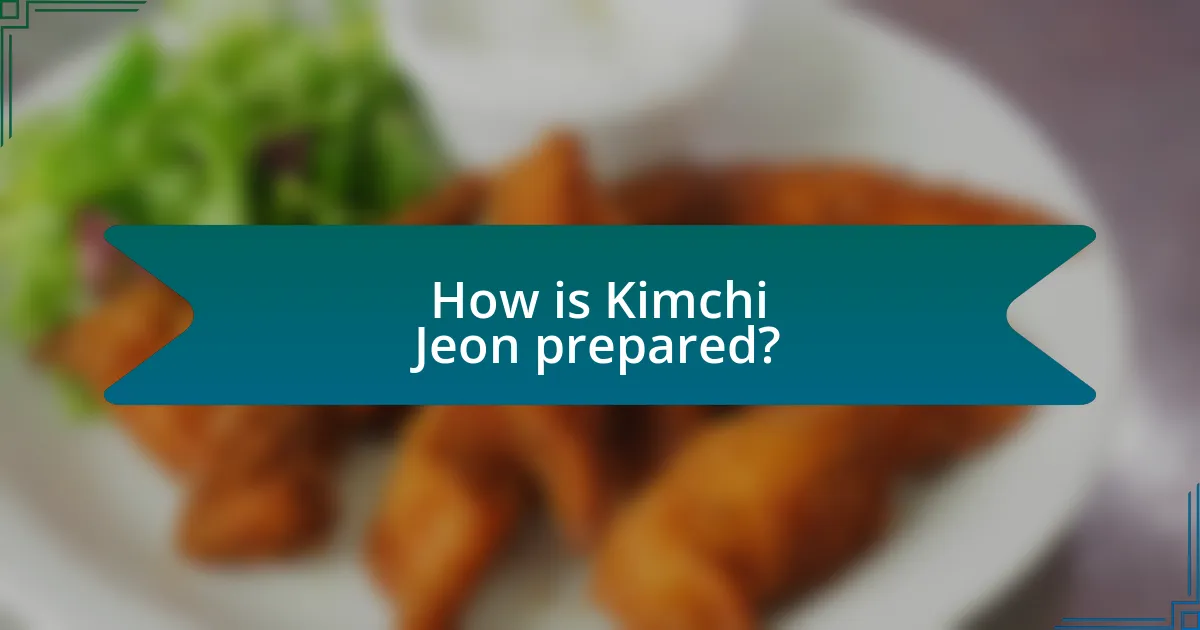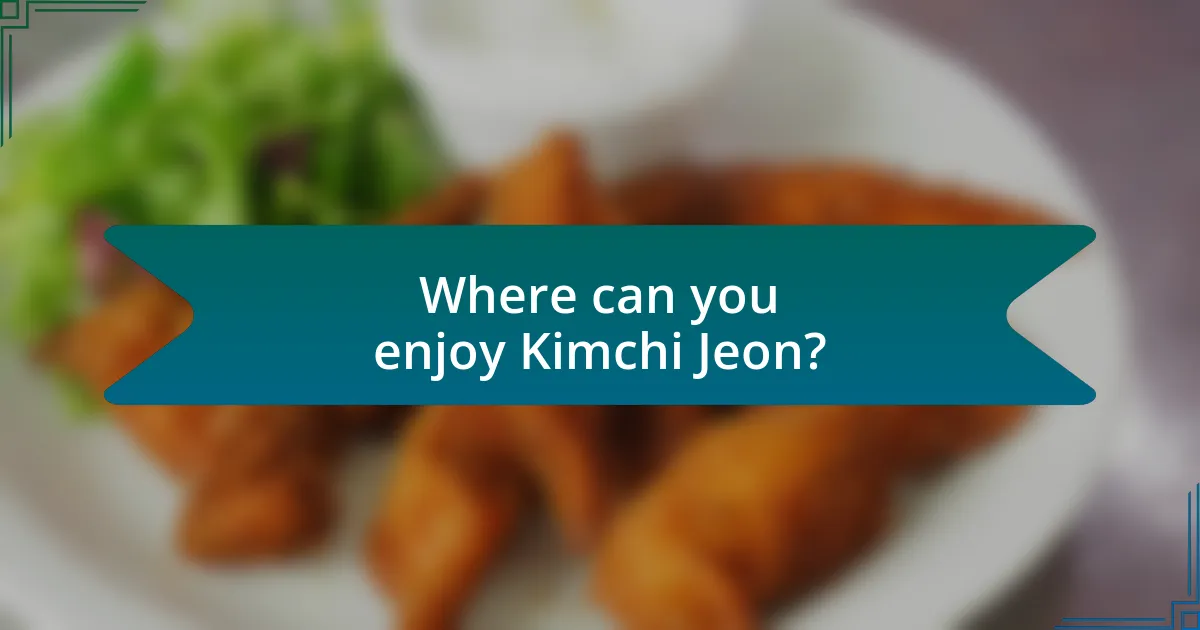Kimchi Jeon is a traditional Korean savory pancake made primarily from kimchi, flour, and water, known for its tangy flavor and crispy texture. This dish stands out from other pancakes due to the incorporation of fermented kimchi, which enhances its umami profile and provides health benefits through probiotics. The article explores the essential ingredients, preparation methods, cultural significance, and health advantages of Kimchi Jeon, as well as variations and tips for making it at home. Additionally, it highlights where to enjoy authentic Kimchi Jeon in restaurants and markets, emphasizing its role in Korean culinary heritage and communal dining.

What is Kimchi Jeon?
Kimchi Jeon is a Korean savory pancake made primarily from kimchi, flour, and water. This dish incorporates chopped kimchi into a batter, which is then pan-fried until crispy. Kimchi Jeon is often enjoyed as a side dish or snack and is known for its tangy flavor and crunchy texture, reflecting the essence of Korean cuisine.
How is Kimchi Jeon different from other pancakes?
Kimchi Jeon is distinct from other pancakes primarily due to its incorporation of fermented kimchi, which imparts a unique tangy flavor and enhances the dish’s umami profile. Unlike traditional pancakes that typically use a simple batter of flour and water, Kimchi Jeon combines this batter with chopped kimchi, often along with vegetables and sometimes seafood, creating a savory, textured dish. The fermentation process of kimchi not only adds depth to the flavor but also contributes probiotics, making it a healthier option compared to many other pancake varieties.
What ingredients are essential for making Kimchi Jeon?
The essential ingredients for making Kimchi Jeon include kimchi, flour, water, and eggs. Kimchi provides the primary flavor and texture, while flour and water create the batter that holds the pancake together. Eggs add richness and help bind the ingredients. These components are fundamental to achieving the characteristic taste and consistency of Kimchi Jeon, a popular dish in Korean cuisine.
How does the fermentation of kimchi influence the flavor of Kimchi Jeon?
The fermentation of kimchi significantly enhances the flavor of Kimchi Jeon by introducing complex, tangy, and umami notes. During fermentation, lactic acid bacteria develop, which not only contribute to the sourness but also deepen the overall taste profile of the kimchi. This sourness and umami richness from the fermented kimchi infuse into the pancake, creating a savory dish that reflects the traditional Korean palate. Additionally, the fermentation process breaks down the vegetables, making them softer and more flavorful, which further enriches the texture and taste of Kimchi Jeon.
What cultural significance does Kimchi Jeon hold in Korean cuisine?
Kimchi Jeon holds significant cultural importance in Korean cuisine as it embodies the principles of resourcefulness and communal eating. Traditionally, Kimchi Jeon is made using leftover kimchi, reflecting the Korean value of minimizing food waste. This dish is often served during family gatherings and celebrations, symbolizing unity and togetherness. Additionally, its preparation and consumption are associated with seasonal changes, particularly during the rainy season, when the dish is enjoyed for its comforting qualities. The historical context of Kimchi Jeon also highlights its role in Korean culinary heritage, as it has been a staple for generations, showcasing the adaptability of Korean cooking practices.
How is Kimchi Jeon traditionally served in Korean households?
Kimchi Jeon is traditionally served in Korean households as a side dish or an appetizer, often accompanied by a dipping sauce made of soy sauce and vinegar. This savory pancake is typically enjoyed hot and crispy, highlighting its texture and flavor. In many households, it is common to serve Kimchi Jeon alongside rice and other banchan (side dishes), making it a staple in family meals. The practice of serving it this way reflects its role in Korean cuisine as a comforting and communal dish.
What occasions are typically associated with making Kimchi Jeon?
Kimchi Jeon is typically associated with celebrations, family gatherings, and rainy days in Korean culture. This savory pancake is often prepared during holidays such as Chuseok (Korean harvest festival) and Seollal (Lunar New Year) as a way to honor family traditions and share food. Additionally, it is commonly made on rainy days because the sound of cooking pancakes is thought to bring comfort and warmth, making it a popular choice for casual meals at home.
What are the health benefits of Kimchi Jeon?
Kimchi Jeon offers several health benefits, primarily due to its ingredients, which include kimchi and flour. The fermentation process of kimchi provides probiotics that support gut health, enhancing digestion and boosting the immune system. Additionally, kimchi is rich in vitamins A, B, and C, which contribute to overall health and may help reduce inflammation. The inclusion of vegetables in Kimchi Jeon adds fiber, promoting satiety and aiding in weight management. Studies have shown that fermented foods like kimchi can also have positive effects on metabolic health, potentially lowering the risk of chronic diseases.
How do the ingredients in Kimchi Jeon contribute to its nutritional value?
The ingredients in Kimchi Jeon significantly enhance its nutritional value by providing a balance of vitamins, minerals, and probiotics. Kimchi, primarily made from fermented vegetables like napa cabbage and radishes, is rich in vitamins A, B, and C, as well as dietary fiber, which supports digestive health. The fermentation process introduces beneficial probiotics that promote gut health and boost the immune system. Additionally, the use of flour in the pancake contributes carbohydrates for energy, while any added proteins, such as eggs or seafood, increase the dish’s protein content, essential for muscle repair and overall health. This combination of ingredients makes Kimchi Jeon a nutrient-dense option that supports various aspects of health.
What role does kimchi play in promoting gut health?
Kimchi plays a significant role in promoting gut health primarily due to its high content of probiotics, which are beneficial bacteria that support digestive health. The fermentation process of kimchi, which typically includes ingredients like napa cabbage and radishes, encourages the growth of Lactobacillus species, a type of probiotic known to enhance gut flora balance. Research indicates that these probiotics can improve digestion, boost the immune system, and may even reduce the risk of gastrointestinal diseases. For instance, a study published in the Journal of Medicinal Food found that regular consumption of fermented foods like kimchi can positively influence gut microbiota composition, leading to improved overall gut health.

How is Kimchi Jeon prepared?
Kimchi Jeon is prepared by mixing chopped kimchi with a batter made from flour, water, and sometimes egg. The mixture is then poured onto a hot, oiled skillet and cooked until both sides are golden brown and crispy. This method highlights the fermented flavors of the kimchi while creating a savory pancake texture.
What are the steps involved in making Kimchi Jeon?
To make Kimchi Jeon, follow these steps: First, prepare the batter by mixing flour, water, and a pinch of salt until smooth. Next, add chopped kimchi and any desired vegetables, such as green onions, to the batter. Heat a pan with oil over medium heat, then pour in the batter to form a pancake. Cook until the edges are crispy and the bottom is golden brown, about 3-4 minutes, then flip and cook the other side for an additional 3-4 minutes. Finally, serve the Kimchi Jeon hot, often with a dipping sauce made of soy sauce and vinegar.
How do you prepare the batter for Kimchi Jeon?
To prepare the batter for Kimchi Jeon, combine all-purpose flour, water, and a pinch of salt in a mixing bowl until smooth. The typical ratio is about 1 cup of flour to 1 cup of water, which creates a thick yet pourable consistency. Additionally, incorporate chopped kimchi and its juice into the batter for flavor and texture. This method ensures that the batter adheres well to the pan and results in a crispy pancake.
What cooking techniques are best for achieving the perfect texture?
The best cooking techniques for achieving the perfect texture in Kimchi Jeon include pan-frying and steaming. Pan-frying allows for a crispy exterior while maintaining a tender interior, which is essential for the desired texture of the pancake. Steaming can also be used to ensure that the ingredients are cooked evenly and retain moisture, contributing to a soft and fluffy texture. These techniques are validated by traditional Korean cooking practices, where the balance of crispiness and softness is crucial for the enjoyment of Kimchi Jeon.
What variations of Kimchi Jeon exist?
Variations of Kimchi Jeon include traditional Kimchi Jeon, which is made primarily with fermented kimchi and a simple batter of flour and water, and variations that incorporate additional ingredients such as seafood, vegetables, or meat. For instance, seafood Kimchi Jeon often includes shrimp or squid, while vegetable Kimchi Jeon may feature zucchini or green onions. Each variation maintains the core elements of kimchi and batter but enhances the flavor profile and texture through these additional components.
How can you customize Kimchi Jeon with different ingredients?
You can customize Kimchi Jeon by incorporating various ingredients such as seafood, vegetables, or different types of flour. For instance, adding shrimp or squid enhances the flavor profile, while incorporating scallions or zucchini can add texture and freshness. Additionally, using rice flour instead of all-purpose flour can create a gluten-free version, catering to dietary preferences. These variations allow for a personalized approach to this traditional dish, making it versatile and adaptable to individual tastes.
What are some popular regional variations of Kimchi Jeon in Korea?
Popular regional variations of Kimchi Jeon in Korea include Jeolla-do’s spicy Kimchi Jeon, which often incorporates seafood like shrimp or squid, and Gyeongsang-do’s version, known for its thicker batter and use of aged kimchi for a more robust flavor. Additionally, the Seoul variant tends to be lighter and crispier, focusing on fresh kimchi. Each region’s unique ingredients and preparation methods reflect local culinary traditions and preferences, showcasing the diversity within this beloved dish.

Where can you enjoy Kimchi Jeon?
You can enjoy Kimchi Jeon at Korean restaurants, particularly those specializing in traditional dishes. Many Korean eateries, both in South Korea and internationally, feature Kimchi Jeon on their menus as it is a popular dish often served as an appetizer or side. Additionally, local markets and food stalls in Korea frequently offer freshly made Kimchi Jeon, showcasing its cultural significance and popularity among locals.
What types of restaurants typically serve Kimchi Jeon?
Korean restaurants typically serve Kimchi Jeon. These establishments often focus on traditional Korean dishes, where Kimchi Jeon, a savory pancake made with fermented kimchi, is a popular menu item. Additionally, casual dining spots, such as Korean BBQ restaurants and izakayas, may also feature Kimchi Jeon as a side dish or appetizer, reflecting its cultural significance in Korean cuisine.
How can you find authentic Kimchi Jeon in your area?
To find authentic Kimchi Jeon in your area, visit local Korean restaurants known for traditional cuisine. Many authentic establishments feature Kimchi Jeon on their menus, often prepared using family recipes that emphasize quality ingredients and traditional cooking methods. Additionally, you can explore community reviews on platforms like Yelp or Google Maps, where diners often share their experiences regarding the authenticity of dishes. Look for restaurants that have a strong reputation for Korean food, as they are more likely to serve genuine Kimchi Jeon.
What are some tips for making Kimchi Jeon at home?
To make Kimchi Jeon at home, use well-fermented kimchi for the best flavor and texture. The fermentation process enhances the umami taste, making the pancakes more savory. Combine the kimchi with a simple batter of flour and water, adjusting the consistency to be slightly thick for better binding. Adding scallions or other vegetables can enhance the flavor and texture. Cook the pancakes in a hot pan with oil until they are crispy on the outside and tender inside, which typically takes about 3-4 minutes per side. This method ensures a delicious, authentic Kimchi Jeon that reflects traditional Korean cuisine.
How can you ensure your Kimchi Jeon turns out crispy and flavorful?
To ensure your Kimchi Jeon turns out crispy and flavorful, use a high ratio of kimchi to batter and incorporate cornstarch into the batter. A higher proportion of kimchi enhances the flavor, while cornstarch contributes to a crispier texture when fried. Additionally, frying in hot oil allows for immediate crisping, preventing the pancake from becoming soggy. Studies show that frying at the right temperature, around 350°F (175°C), optimizes the Maillard reaction, which enhances flavor and browning.
What common mistakes should you avoid when making Kimchi Jeon?
When making Kimchi Jeon, avoid using overly watery batter, as this can lead to a soggy pancake. A common mistake is not allowing the kimchi to drain properly, which can introduce excess moisture. Additionally, using old or overly fermented kimchi can result in an unbalanced flavor; fresh kimchi is recommended for optimal taste. Lastly, cooking at too high a temperature can cause the outside to burn while leaving the inside undercooked, so maintaining a medium heat is crucial for even cooking.


